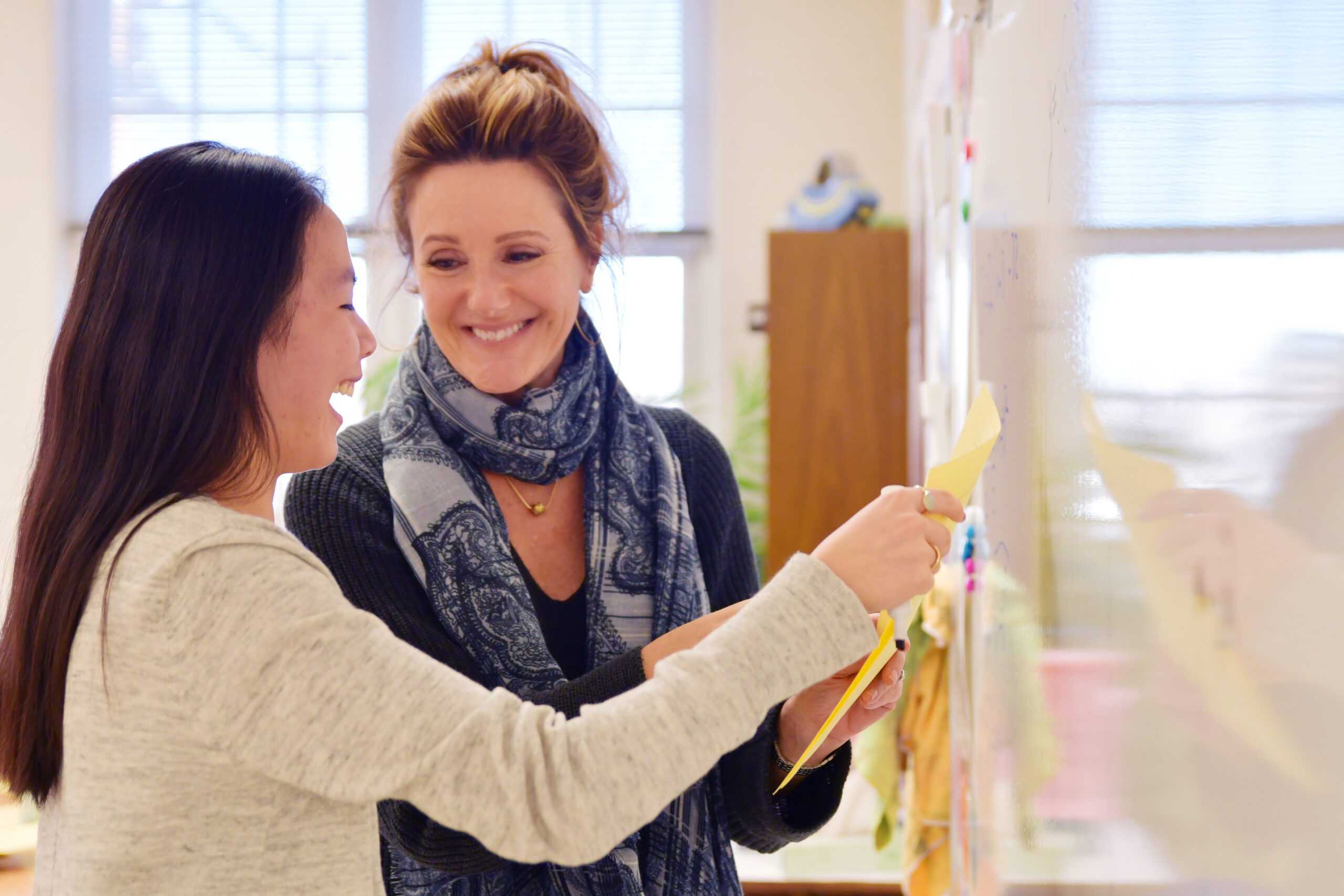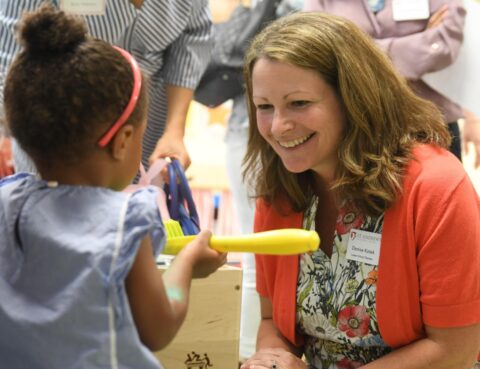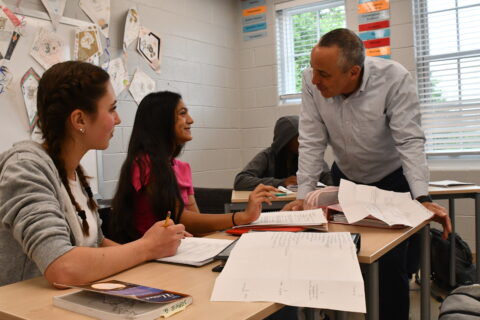By Karen Kaufman
Editor’s Note: This article was originally published in Volume 3 of “Think Differently and Deeply” (2018).
Have we learned this before? Few student inquiries are more unnerving for a teacher distributing a final exam review packet at the end of an ostensibly successful year than this one. Calmly, we state, “Yes, we studied that earlier in the year!” and instinctively hide our exasperation and disappointment. We are frustrated at ourselves for failing to help our students learn and disappointed that even given our best efforts many of our students perfected the science of forgetting more skillfully than the art of remembering.
As professional educators, we know our role is to promote learning and not just cover curriculum. However, few of us are righteous enough to say that fostering learning is not in perpetual conflict with the need (artificial or real) to cover a prescribed curriculum.
Even when we enthusiastically infuse our classes with hands-on activities, group work, purposeful connections, and multi-media delivery, the result is more often than not a chapter by chapter, linear presentation of topics that will produce the dreaded year-end question: “Have we learned this before?”
In the late 1800s, Hermann Ebbinghaus, a German psychologist, became known for his research on memory retrieval, aptly named the “forgetting curve.” Ebbinghaus’ forgetting curve has the shape of a decreasing exponential function, which is disturbing to a math teacher because the greatest rate of decline in memory, i.e. the steepest portion of the curve, occurs within the first few hours or days of learning a new topic. All students, even high achieving, highly motivated ones, forget huge swathes of what they learned. For example, Eugène Custers found that medical students forget 30% of basic science facts in one year, and over 50% in two. (1) How can we improve this?
From his research, Ebbinghaus determined that an individual’s ability to retain information is dependent on two main factors: the strength or durability of the memory and the amount of time passed since learning it. Strength or durability of memory is a complex attribute associated with individual relevance, connection, and the use of memory representation like a mnemonic device. This aspect of learning is one that educators focus on naturally. Making content relevant, helping students make connections, and providing study strategies like mnemonic devices are the cornerstones of excellent teaching. (2)
The effect of elapsed time on retention is a feature of learning that teachers pay less attention to, even though the amount of research on it is large, robust and compelling. Ebbinghaus, along with many researchers since then,(3,4) confirmed that retention is dramatically improved when material is relearned at spaced intervals. Spaced repetitions—forcing ourselves to recall information just as we are beginning to forget it—serve as reminders that bolster memory and have the effect of flattening out the forgetting curve. The graph below shows a flattening of the forgetting curve with each repetition or review of material.
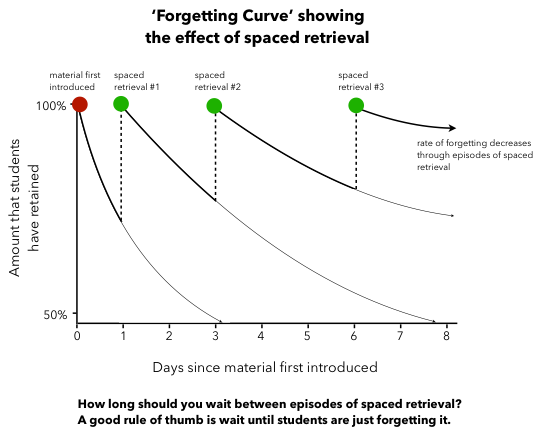
We keep the spacing effect in mind as we plan each unit of study leading up to a summative assessment, creating a rhythm that helps students learn the material. But what if we applied the spacing effect throughout an entire year-long course? What would that look like? This is called interleaving. Instead of going linearly through each unit, we revisit topics again and again just as students begin to forget the material, as shown in the diagram below. This seems like the optimum way to plan a course in a way that is design to make it stick in students’ minds.
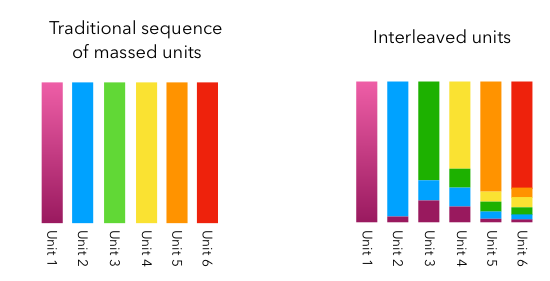
However, interleaving, isn’t the norm in most classroom environments. First, our course materials, presented chapter-by-chapter, don’t lend themselves to interleaving. Second, as educators, it seems unnatural to leave a topic before students have mastered it, and mastery typically culminates in a large unit assessment for which the vast majority of students will cram. The forgetting curve demonstrates that cramming, or trying to remember vast material in one study session, is the least effective method for learning. It should come as no surprise then that a year of linearly presented topics with few opportunities to review, revisit, and relearn material at spaced intervals results in that dreaded student question: “Have we learned this before?” (5)
Armed with this research and weary of the influence of the forgetting curve on our students, a colleague and I decided to overhaul our Algebra 2 Trigonometry curriculum during the 2016-2017 school year. We began by deconstructing the entire course. We created a list of overarching topics that we wanted the students to master, and, using large flash cards, we taped each of these topics across a white board in the front of a classroom. We spent hours ordering and reordering these topics until we were comfortable that each topic connected logically to the next. Under each topic we listed subtopics based on their ability and relevance to support what we wanted the students to learn. The textbook, websites, and other online materials were used as secondary resources.
To interleave our curriculum, we designed homework that included ideas presented in prior units and assessed a topic only after students had multiple opportunities to practice it. We provided weekly graded algebra review worksheets that continually reinforced prior content. Interleaving required significant planning and detailed calendaring. A calendar for a week could include teaching geometric series, giving homework on exponential functions, and preparing students for a quiz or test on a unit learned the prior month.
Listen to Karen talk about redesigning her curriculum in Episode 8 of the Think Differently and Deeply Podcast, recorded in 2018.
Fast forward to the end of the year. The day arrives to distribute final exam review packets. We distribute the packets and instruct students to preview them. We wait for the dreaded question that never came. The students begin working. Not even one student asked, “Have we learned this before?”
So was interleaving successful? It is difficult to know for sure. We can say that final exam preparation seemed to be significantly less stressful for the students than in prior years, and that there were few “very poor” exam grades. Written feedback solicited from students at the end of the exam indicated that they felt well prepared and thought the exam was fair. So, where will these students be on the forgetting curve in the fall when they arrive to their Pre-calculus class, a course that is completely dependent on material learned in Algebra 2 Trigonometry? As luck would have it, I am teaching Pre-calculus next year. Stay tuned…..
Karen Kaufman is an Upper School Math teacher at St. Andrew’s Episcopal School.
Citations
1) E. Custers (2010). “Long-term retention of basic science knowledge: a review study.” Advances in Health Science Education: Theory & Practice, 15(1), 109-128.
2) Peter C. Brown, Henry L. Roediger III, and Mark A. McDaniel, Make It Stick: The Science of Successful Learning (Cambridge, Massachusetts: Belknap Press, 2014).
3) John Dunlosky, Katherine Rawson, Elizabeth Marsh, Mitchell Nathan, and Daniel Willingham (2013) “Improving Students’ Learning With Effective Learning Techniques: Promising Directions From Cognitive and Educational Psychology.” Psychological Science in the Public Interest 14(1) 4—58.
4) H. Pashler, P. Bain, B. Bottge, A. Graesser, K. Koedinger, M. McDaniel, and J. Metcalfe (2007). “Organizing Instruction and Study to Improve Student Learning” (NCER 2007-2004). Washington, DC: National Center for Education Research, Institute of Education Sciences, U.S. Department of Education. Retrieved from (http://ncer.ed.gov).
5) Josette Akresh-Gonzales. “Spaced Repetition: The Most Effective Way to Learn.”, (https://knowledgeplus.nejm.org/blog/spaced-repetition-the-most-effective-way-to-learn/) (accessed July 10, 2017).
6) Interleaved versus traditional massed sequence of units, adapted from Lindsey, Shroyer, Pashler, & Mozer (2014). Improving students’ long-term knowledge retention through personalized review. Psychological Science, 25, 639-647.

